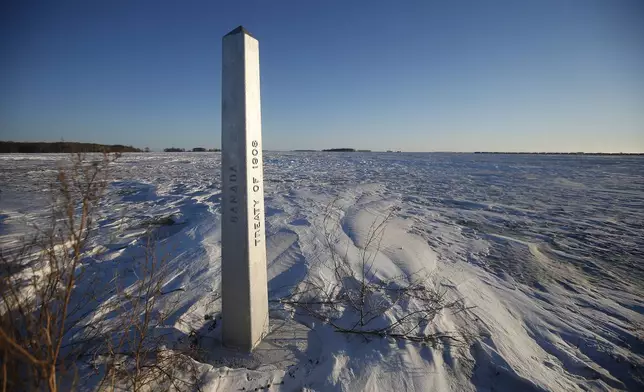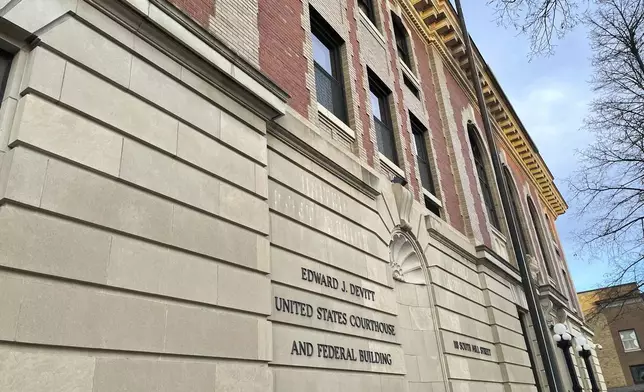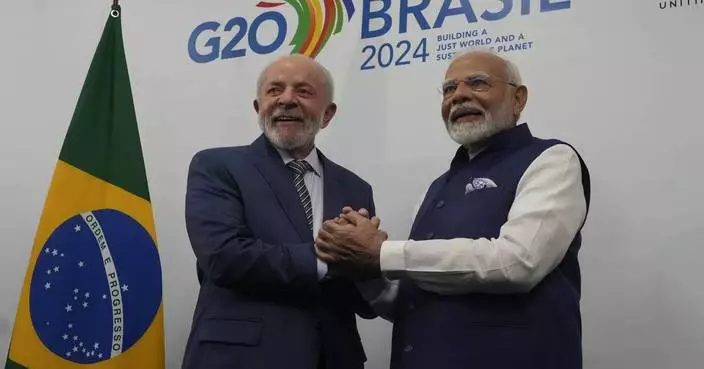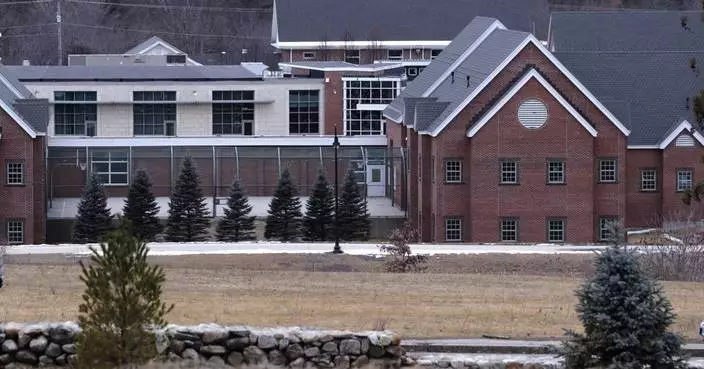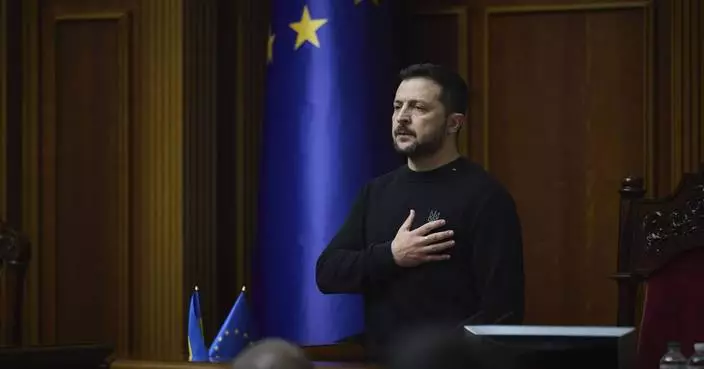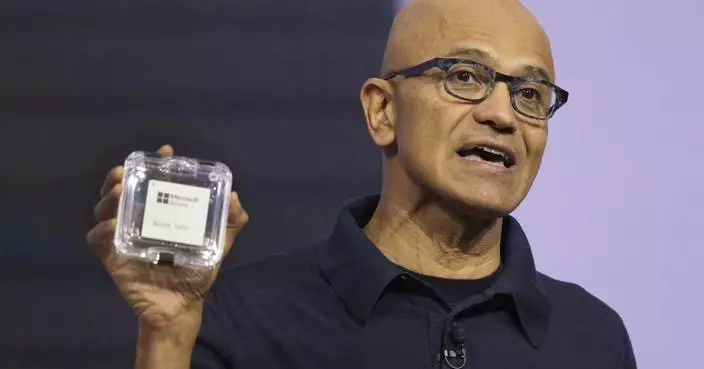FERGUS FALLS, Minn. (AP) — An Indian migrant who survived a deadly trek across the Canada-U.S. border in blizzard conditions is expected to testify Tuesday in the federal trial of two men accused of taking part in a sprawling human smuggling scheme that ultimately killed a family of four.
Prosecutors allege Indian national Harshkumar Ramanlal Patel, 29, and Steve Shand, 50, put financial profit over human life when they attempted to smuggle Indian migrants across the border into Minnesota over a five-week period. They say Patel ran part of the smuggling scheme and recruited Shand as a driver. Both men have pleaded not guilty to four federal counts related to human smuggling.
Click to Gallery
Women walks past an entrance gate of Dingucha village in Gandhinagar, India, Tuesday, Nov. 12, 2024. (AP Photo/Ajit Solanki)
FILE - A border marker, between the United States and Canada is shown just outside of Emerson, Manitoba, on Thursday, Jan. 20, 2022. (John Woods/The Canadian Press via AP, File)
In an image released by the U.S. Attorney’s Office, shows how the migrants who survived the crossing were terribly inadequately dressed. (U.S. Attorney's Office via AP)
In an undated image released by the U.S. Attorney’s Office, shows items found in a migrant child’s backpack. (U.S. Attorney's Office via AP)
The Edward J. Devitt U.S. Courthouse and Federal building is seen, where two men on trial face human smuggling charges, Monday, Nov. 18, 2024, in Fergus Falls, Minn. (AP Photo/Michael Goldberg)
FILE - Road signage is posted just outside of Emerson, Manitoba on Thursday, Jan. 20, 2022. (John Woods/The Canadian Press via AP)
Prosecutors say the family of four — 39-year-old Jagdish Patel; his wife, Vaishaliben, who was in her mid-30s; their 11-year-old daughter, Vihangi; and 3-year-old son, Dharmik — froze to death Jan. 19, 2022, after spending hours wandering in heavy snow and bone-chilling cold. Shand had been waiting in a truck for 11 migrants, including the family from Gujarat state, as the wind chill reached minus 36 degrees Fahrenheit (minus 38 degrees Celsius).
The witness expected to testify Tuesday, Yash Patel, is one of two people who managed to reach Shand on the other side of the border. He was arrested along with Shand after a border patrol officer pulled them over before they could escape, prosecutors said.
Patel is a common Indian surname and the victims were not related to Harshkumar Patel.
Prosecutors began building their case Tuesday by calling witnesses who spoke of the brutal conditions under which the Patel family trudged through vast, snow-filled fields and high winds.
Daryl Ritchison, a climatologist and director of the North Dakota Agricultural Weather Network, said temperatures were abnormally cold that January morning and that frostbite can occur within 10 minutes in those conditions.
Troy Larson, a mechanic, said he helped dig a van belonging to a man matching Shand’s description out of a ditch on the side of a desolate stretch of road that morning. Inside the van allegedly driven by Shand, Larson said he observed a person wrapped in a blanket and a child. The van then drove off.
Around the same time, Christopher Oliver, a U.S. border patrol agent had been headed in the van's direction. In the weeks prior, he had seen footprints in the snow and suspected people had been trying to cross the border. He spotted the van and pulled it over. He identified Shand as the driver and arrested him.
Shand and Harshkumar Patel knew the winter weather conditions were extreme but chose to go forward with a plan to smuggle migrants across the border on foot anyway, prosecutor Ryan Lipes said Monday in his opening statement.
"The migrants were dropped at a dark, isolated part of the Canadian border nowhere near a legal port of entry,” Lipes said.
When Jagdish Patel's body was found, he was holding Dharmik, who was wrapped in a blanket, prosecutors added.
“This case is about these two men putting profit over people’s lives, profit they earned by smuggling migrants from India across the Canadian border into the U.S.,” Lipes told the jury.
Thomas Leinenweber, Harshkumar Patel's attorney, said in his opening statement that no one would testify Patel ever talked about a smuggling conspiracy or provided visual evidence of his involvement.
"One of the worst feelings universally that anyone could feel is when you are wrongfully accused,” Leinenweber said.
Shand's attorney, Lisa Lopez, asked the jury to differentiate between the two defendants. She said Shand was an unwitting participant in the smuggling ring.
“Mr. Shand was used by Mr. Patel. And being used does not equate under the law to being guilty of conspiracy,” Lopez said.
Lopez said Shand and the migrants were duped by Patel and the smuggling network. On Tuesday, Leinenweber argued Shand’s defense is antagonistic and prejudicial against his client.
Federal prosecutors say Harshkumar Patel and Shand were part of an international criminal network that scouted for clients in India, got them Canadian student visas, arranged transportation and smuggled them into the U.S., mostly through Washington state or Minnesota.
Prosecutors say Shand told investigators that Patel paid him about $25,000 for the five trips.
The U.S. Border Patrol arrested more than 14,000 Indians on the Canadian border in the year ending Sept. 30. By 2022, the Pew Research Center estimates more than 725,000 Indians were living illegally in the U.S., behind only Mexicans and El Salvadorans.
Prosecutors filed court documents showing Harshkumar Patel was in the U.S. illegally after being refused a visa at least five times and that he recruited Shand at a casino near their homes in Deltona, Florida, just north of Orlando.
Over five weeks, court documents show, Patel and Shand often communicated about the bitter cold as they smuggled five groups of Indians over a quiet stretch of the border. One night in December 2021, Shand messaged Patel that it was “cold as hell” while waiting to pick up one group, the documents say.
“They going to be alive when they get here?” he allegedly wrote.
During the last trip in January, prosecutors say Shand had messaged Patel, saying: “Make sure everyone is dressed for the blizzard conditions, please."
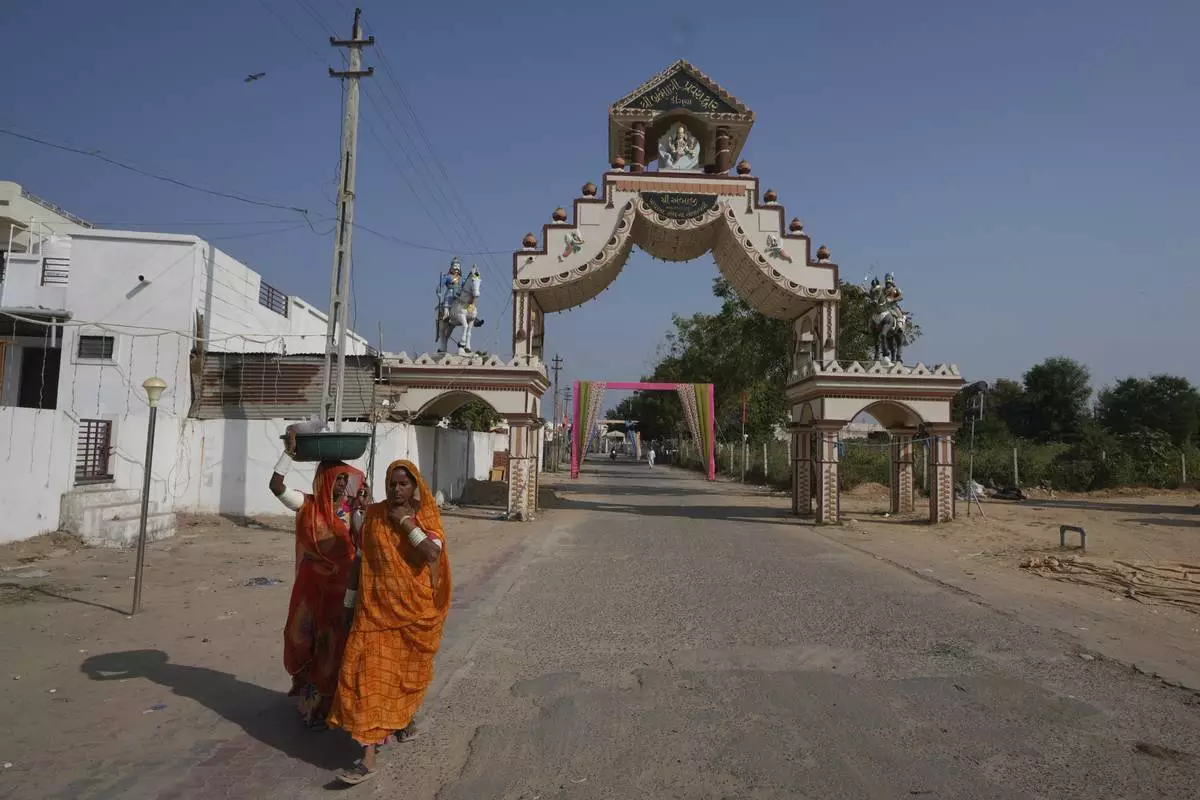
Women walks past an entrance gate of Dingucha village in Gandhinagar, India, Tuesday, Nov. 12, 2024. (AP Photo/Ajit Solanki)

FILE - A border marker, between the United States and Canada is shown just outside of Emerson, Manitoba, on Thursday, Jan. 20, 2022. (John Woods/The Canadian Press via AP, File)
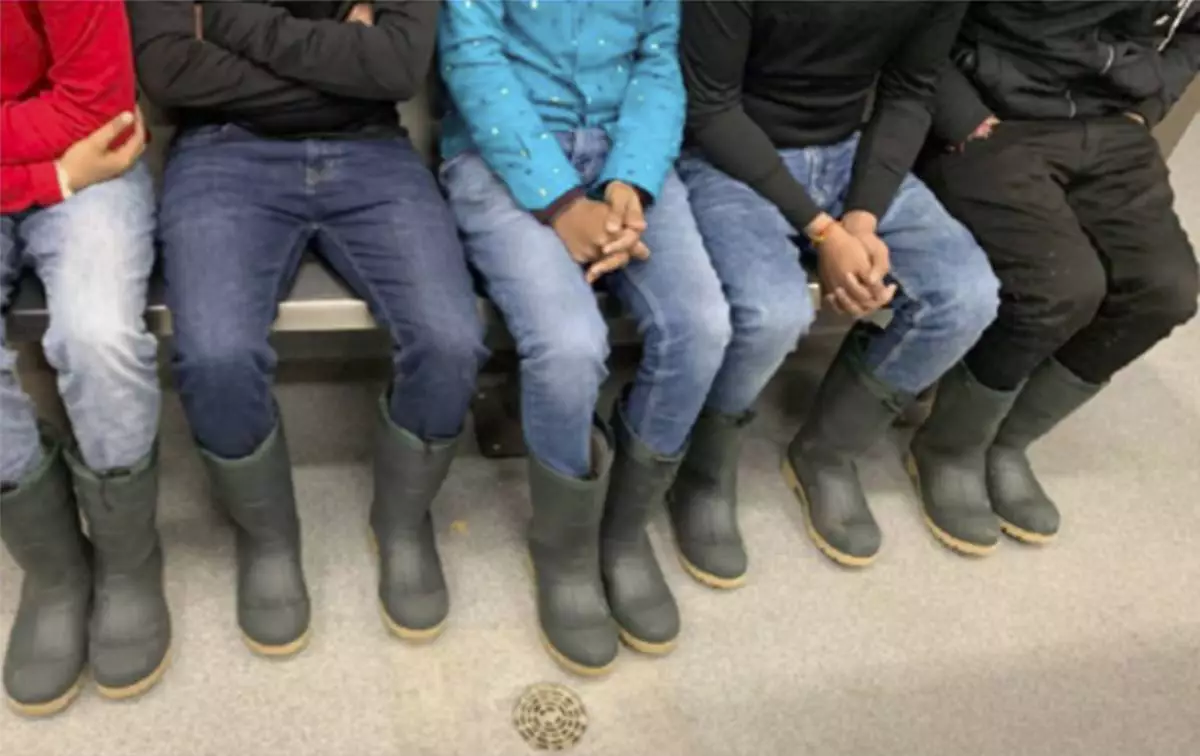
In an image released by the U.S. Attorney’s Office, shows how the migrants who survived the crossing were terribly inadequately dressed. (U.S. Attorney's Office via AP)
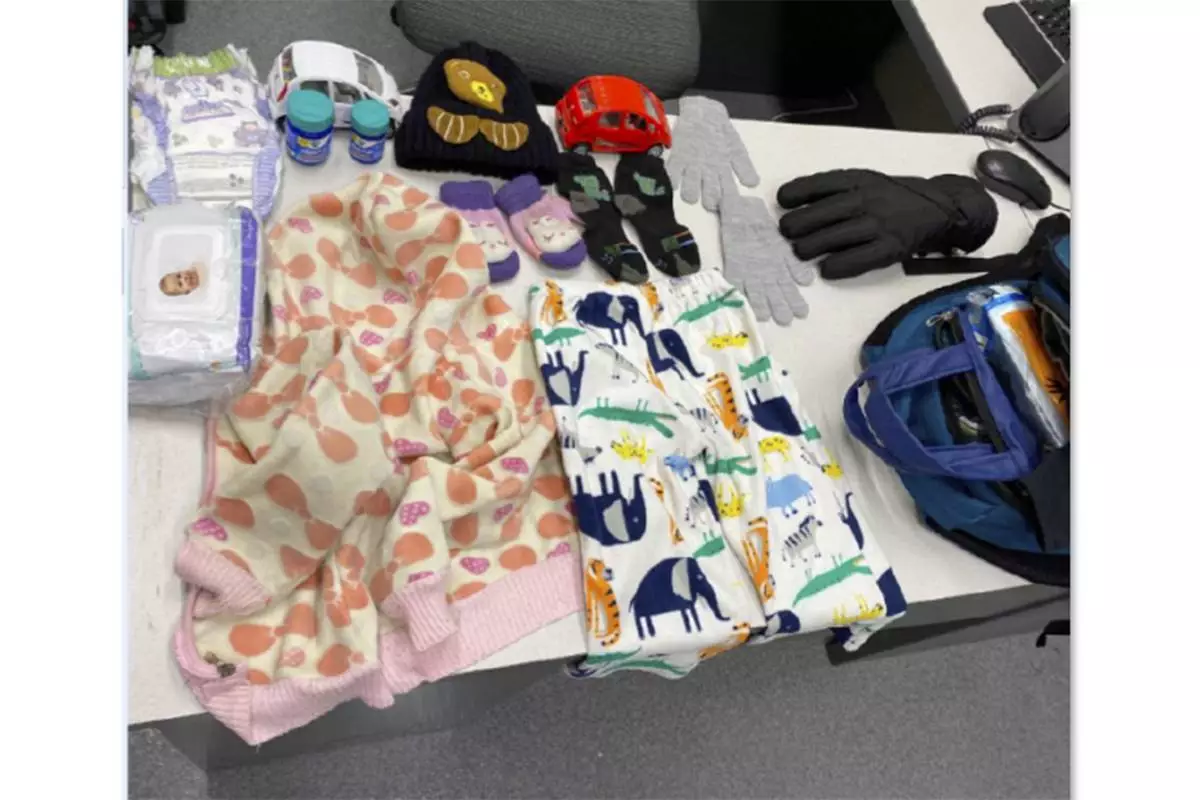
In an undated image released by the U.S. Attorney’s Office, shows items found in a migrant child’s backpack. (U.S. Attorney's Office via AP)

The Edward J. Devitt U.S. Courthouse and Federal building is seen, where two men on trial face human smuggling charges, Monday, Nov. 18, 2024, in Fergus Falls, Minn. (AP Photo/Michael Goldberg)

FILE - Road signage is posted just outside of Emerson, Manitoba on Thursday, Jan. 20, 2022. (John Woods/The Canadian Press via AP)
VIENNA (AP) — Iran has defied international demands to rein in its nuclear program and has increased its stockpile of uranium enriched to near weapons-grade levels, according to a confidential report by the United Nations’ nuclear watchdog seen Tuesday by The Associated Press.
The report by the International Atomic Energy Agency said that as of Oct. 26, Iran has 182.3 kilograms (401.9 pounds) of uranium enriched up to 60%, an increase of 17.6 kilograms (38.8 pounds) since the last report in August.
Uranium enriched at 60% purity is just a short, technical step away from weapons-grade levels of 90%.
The IAEA also estimated in its quarterly report that as of Oct. 26, Iran’s overall stockpile of enriched uranium stands at 6,604.4 kilograms (14,560 pounds), an increase of 852.6 kilograms (1,879.6 pounds) since August. Under the IAEA’s definition, around 42 kilograms (92.5 pounds) of uranium enriched to 60% purity is the amount at which creating one atomic weapon is theoretically possible — if the material is enriched further, to 90%.
The reports come at a critical time as Israel and Iran have traded missile attacks in recent months after more than a year of war in Gaza, which is governed by Hamas, a group supported by Iran.
Adding to the complexity, Donald Trump’s reelection raises questions about whether and how the incoming administration and Iran may engage.
Trump’s first term in office was marked by a particularly troubled period, when he pursued a policy of “maximum pressure” against Tehran. He unilaterally withdrew America from Iran’s nuclear deal with world powers, leading to sanctions hobbling the economy and ordered the killing of the country’s top general.
Iran last week offered not to expand its stockpile of uranium enriched up to 60%, during a visit to Tehran by the IAEA chief, Rafael Mariano Grossi.
The IAEA said during the meetings that “the possibility of Iran not further expanding its stockpile of uranium enriched up to 60% U-235 was discussed, including technical verification measures necessary for the Agency to confirm this, if implemented.”
The report said that one day after Grossi left Iran, on Nov. 16, IAEA inspectors verified that “Iran had begun implementation of preparatory measures aimed at stopping the increase of its stockpile of uranium enriched up to 60 % U-235” at its underground nuclear sites in Fordow and Natanz.
The reports come ahead of this week’s regular IAEA Board of Governors meeting in Vienna.
A western diplomat, who spoke on the condition of anonymity to discuss a sensitive matter, confirmed to the AP that the United Kingdom, France and Germany, with the support from the U.S., are going ahead with a resolution at this week’s IAEA Board of Governors meeting, censuring Iran for its lack of cooperation, leading to potential confrontation with Iran ahead of Trump’s return to the White House.
A senior diplomat, who spoke on the condition of anonymity because of the sensitivity of the issue, said it is possible that the commitments made by Iran during the IAEA’s chief visit may not stand in case a resolution is passed. In the past, Iran has responded to resolutions by the IAEA Board of Governors by further enhancing its nuclear program.
Iran has maintained its nuclear program is for peaceful purposes only, but Grossi has previously warned that Tehran has enough uranium enriched to near-weapons-grade levels to make “several” nuclear bombs if it chose to do so. He has acknowledged the U.N. agency cannot guarantee that none of Iran’s centrifuges may have been peeled away for clandestine enrichment.
Iran’s mission at the United Nations in New York did not immediately respond to a request for comment.
The IAEA also reported that Iran has failed to take concrete steps as of now to improve cooperation, despite pleas by Grossi, who held talks last week with Mohammad Eslami of the Atomic Energy Organization of Iran, Iranian Foreign Minister Abbas Araghchi and Iran’s reformist President Masoud Pezeshkian.
However, Tuesday’s confidential report also said that during Grossi’s visit to Iran on Nov. 14, “Iran agreed to respond to the Agency’s concerns related to Iran’s withdrawal of the designation of several experienced Agency inspectors by considering the acceptance of the designation of four additional experienced inspectors.”
In September 2023, Iran barred some of the Vienna-based agency’s most experienced inspectors.
The report also said there was no progress thus far in reinstalling more monitoring equipment, including cameras, removed in June 2022. Since then, the only recorded data comes from IAEA cameras installed at a centrifuge workshop in Isfahan in May 2023 — although Iran has not provided the IAEA with access to this data and inspectors have not been able to service the cameras.
Last week, Eslami warned that Iran could retaliate if challenged at the upcoming IAEA board meeting. Grossi acknowledged some nations were considering taking action against Iran.
In an effort to ensure Iran could not develop atomic weapons, world powers struck a deal with Tehran in 2015 under which it agreed to limit enrichment of uranium to levels necessary for nuclear power in exchange for the lifting of economic sanctions. U.N. inspectors were tasked with monitoring the program
Under the original 2015 nuclear deal, Iran was allowed to enrich uranium only up to 3.67% purity, can maintain a stockpile of uranium of 300 kilograms and is permitted to use only very basic IR-1 centrifuges, machines that spin uranium gas at high speed for enrichment purposes.
A year after the U.S. withdrawal from the deal under Trump, Iran started to gradually abandon all limits the deal put on its program and began enriching uranium to up to 60% purity.
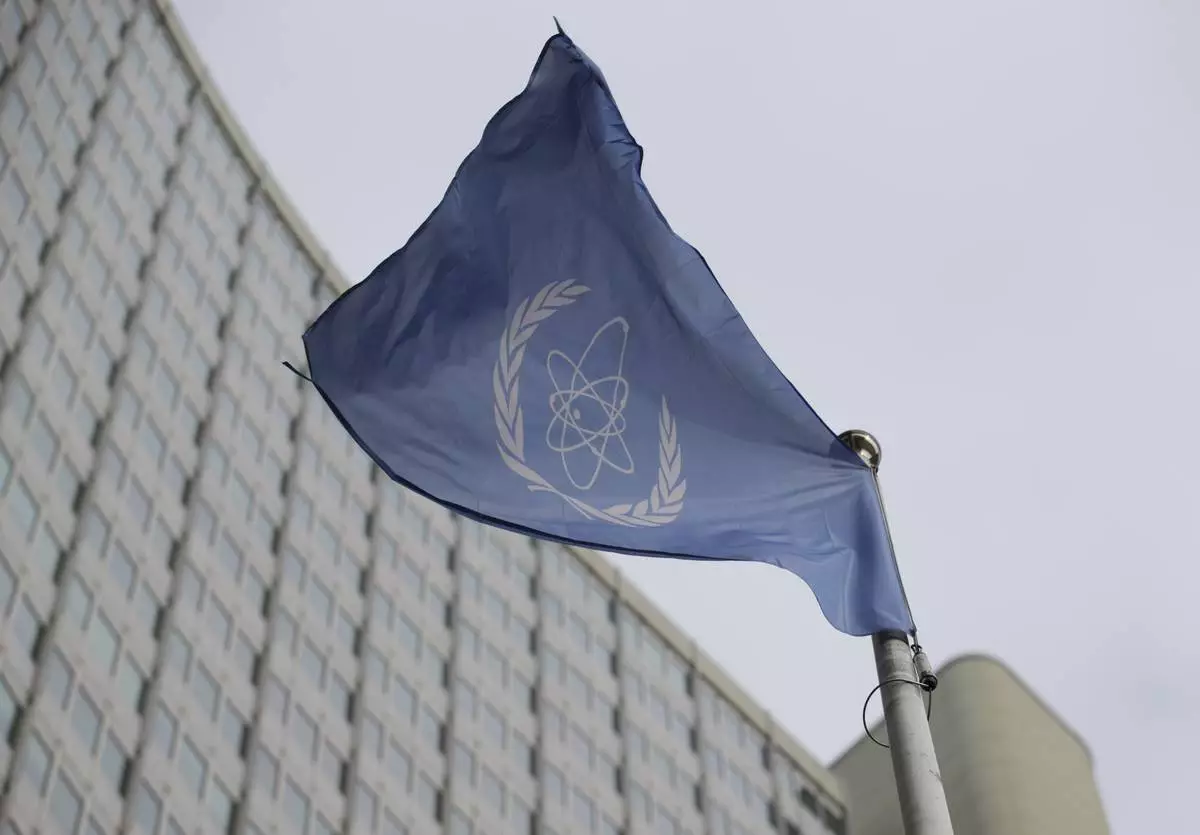
FILE - The flag of the International Atomic Energy Agency flies in front of its headquarters during an IAEA Board of Governors meeting in Vienna, Austria, on Feb. 6, 2023. (AP Photo/Heinz-Peter Bader, File)










